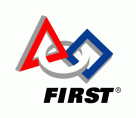Upcoming Events:
Error 406 - Not Acceptable
Generally a 406 error is caused because a request has been blocked by Mod Security. If you believe that your request has been blocked by mistake please contact the web site owner.
Full event list
Error 406 - Not Acceptable
Generally a 406 error is caused because a request has been blocked by Mod Security. If you believe that your request has been blocked by mistake please contact the web site owner.
FIRST® Robotics Competition (FRC®)
Control System 2009-2014
Control System Hardware Setup

Follow the step-by-step directions in the FIRST Control System manual.
FRC 2011 Control System Manual
FRC 2010 Control System Manual
FRC 2009 Control System Manual
Power

The system requires several different voltages
- 5v - for the Axis Ethernet camera and D-Link robot WiFi (special converter 12v-to-5v)
- 6v - selectable by Digital sidecar jumper for powering servos
- 12v - motors, solenoids, and analog sensors
- 24v - for the cRIO and optional 24v solenoids
Tools and materials needed include:
- Wire strippers
- Wire cutters
- Wago tool
- #6 ring terminal crimpers
- #12 ring terminal crimpers
- 10mm nut driver
- 7/16 nut driver or rachet & 7/16 socket
- Medium straight bladed screwdriver
- #6 wire
- #6 ring or clamp terminals
- #18 wire
- #12+ wire (for motors)
- #12 ring terminals
A typical order for connecting everything is:
- 12V Battery to 120amp breaker/switch (requires #6 clamp or crimp terminals and tools)
- 12V battery and 120amp switch to Power Distribution Panel (PD) CAUTION: the nuts on the PD are metric NOT 1/4-20
- PD to cRIO via 24v connector
- PD to wireless bridge using special 12v connection
- PD to camera using 5v connection
- PD standard 12v breaker to wago connectors on the Analog Bumpers, Digital Sidecar, and Pneumatic Bumper
- PD to Speed Controllers and spikes
- Digital Sidecar to robot signal light
- Solenoid wires to the solenoid bumper (optionally to a spike)
Control
- 37-pin cable from the cRIO to the Digital Sidecar
- 25-pin Dsub connectors for the Analog and pneumatic bumpers/breakout boards
- Ethernet cables for the WiFi
- Ethernet cable as a pit tether
- PWM cables for speed controllers, servos, relays, solenoids, analog & digital sensors
- Homemade/purchased CAN cables if optional CAN is used with Jaguar speed controllers(only)
- I2C Interface communication connection
 PWM Control
PWM Control
|
 Serial-CAN Control
Serial-CAN Control
|
 Ethernet-CAN Control
Ethernet-CAN Control
|
Connections to make:
- Driver Station (DS) to cRIO - lots of IP Network Variations , simplest is DS via wireless to robot access point(AP), then AP Ethernet connection to cRIO port 1
- Ethernet cross-over cable from camera to cRIO port 2
- DB37 cable from cRIO module 4 to the Digital Sidecar (optionally from module 6 to a 2nd Digital Sidecar)
- Servos attached to white PWM outputs. For Servos Only, 2-pin jumpers go beside the servo PWM pins to give them power.
- PWM cables from Spikes to the Relay pins on a Digital Sidecar
- PWM cables from the white PWM pins on the Digital Sidecar to Victor speed controllers
- Jaguar speed controllers have three control options: PWM, Serial-CAN, Ethernet-CAN. see diagrams.
Get Microsoft Excel Viewer
Get Microsoft PowerPoint Viewer
Get WinZip

